Today, I will show you how to play Pudong from a designer's perspective.
200+ per person, super city nanny-style intimate arrangements, start your trip to Pudong Jersey.
👉First get a Pudong Tonghui Card (one card for two people)! Starting from 538r, including a meal for two people + one hotel night + one attraction ticket for two people! ! ! It can be split and used, or it can be consumed directly in 2 days and 1 night~~Super convenient! !
🌟Day 1 Feel the changes of Shanghai by the Huangpu River
🗺Route: Expo Source⏩Houtan Park⏩Twin Hills⏩Lujiazui⏩Oriental Pearl Tower⏩Qiantan
📍Expo Source: 15 years have passed since the World Expo, let’s go back to the 10s at the China Art Museum
📍Houtan Park: A sponge city sample designed by Turenscape, a breathing park where you can camp and ride bicycles
📍Expo Cultural Park: Climb the artificial 4,800-cm twin peaks, which can be reached in 10 minutes, and check in at the greenhouse garden
📍Lujiazui: Check in three sets, take photos of life, and climb Top of Shanghai, overlooking the prosperous Magic City
🍚At noon, I started the "Pudong Tonghui Card" trip to get the best deals. I went to OTF California Restaurant in Lujiazui to exchange for a double meal. The taste was very American, the atmosphere was very chill, and it was also beyond the movie (I saw the original price of this set meal was actually several hundred yuan more)
📍Oriental Pearl: The beginning of Pudong's prosperity, let's take a group photo
📍Qiantan: Watch a concert at Mercedes-Benz, or play frisbee 🥏/flag football 🏈 at Qiantan Sports Park, go shopping in Taikoo Li to digest the food, and feel the young and lively Magic City
Apple U, this route is really fulfilling❗️
🏨 At night, I used the Tonghui Card to exchange for a hotel nearby, which was super convenient! ! I feel that just staying for one night is worth the ticket 💰! !
💓Day 2: Peach blossoms in Pudong
🗺️Nanhui Peach Blossom Festival⏩Pudong Lalaland
📍Pudong’s card includes a ticket for two to the Nanhui Peach Blossom Festival!! Super cost-effective!!! Very interesting, the boat ride in the park, the peach blossoms in the garden, give everyone the healing of spring, and for a moment I felt like it was an afternoon in 2008, and I had a very long dream~
📍After watching, you can also check in at the Shanghai Planetarium and Ocean Park in Lingang
📍Pudong Lalaland-Yangjing Port: Get the same atmosphere of sunset as "La La Land" at the Shanghai Xiepu Ferry 🌅Come and see it before 5pm~
Sign in to join the conversation
Sign InThe night view of Shanghai is really charming, especially the view of Pudong from the Bund, which is definitely a good place to take pictures!
The deadline is approaching, and I have sorted out the three-day Shanghai travel guide & strategy overnight | with the route attached. I wish you all a happy journey🤩🥳 💓Day 1️⃣ 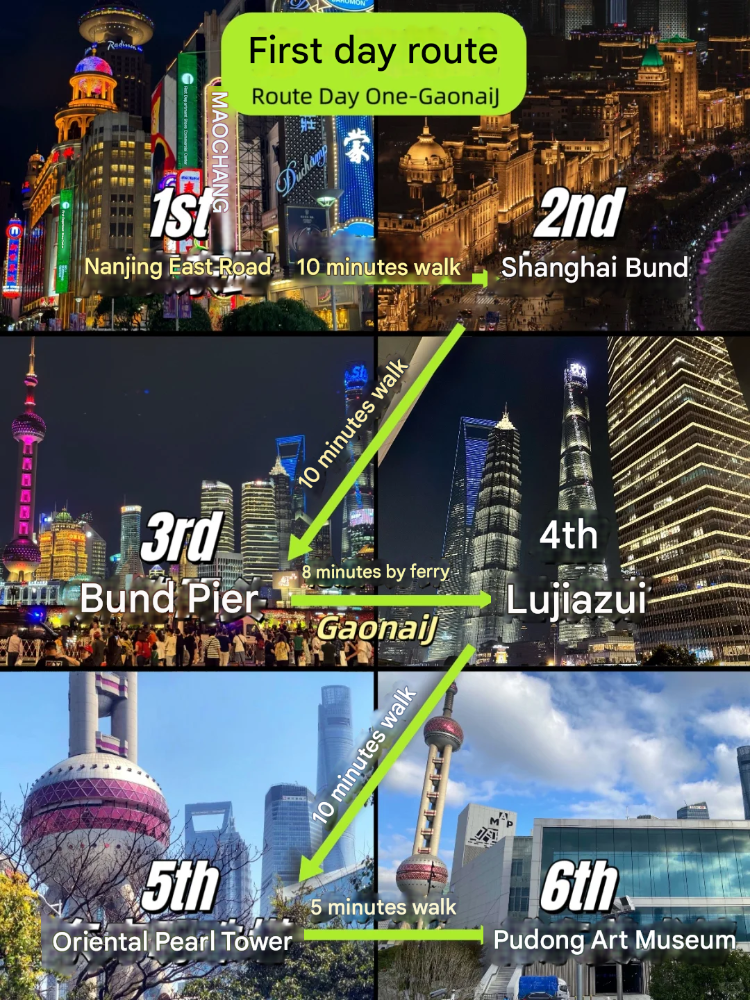 🗺️Route: Nanjing East Road⏩️Shanghai Bund⏩️Bund Pier⏩️Lujiazui⏩️Oriental Pearl Tower⏩️Pudong Art Museum 📍Nanjing East Road: "China's No. 1 Commercial Street", showing Shanghai's unique urban charm and the glory of a century-old business vein 📍Shanghai Bund: The bright pearl of the World Architecture Expo, standing along the river, it is very shocking to turn on the lights at 7:30 pm 📍Bund Pier: Feel the bright lights of the Magic City at night, it is a great place to watch The best place to enjoy the beautiful view of Huangpu River and feel the city style of Shanghai 📍Lujiazui: Shanghai's super landmark, skyscrapers, 360° check-in point 📍Oriental Pearl Tower: landmark, cool light show, you can climb the tower for sightseeing 📍Pudong Art Museum: exhibition, literary check-in point 💓2️⃣Day 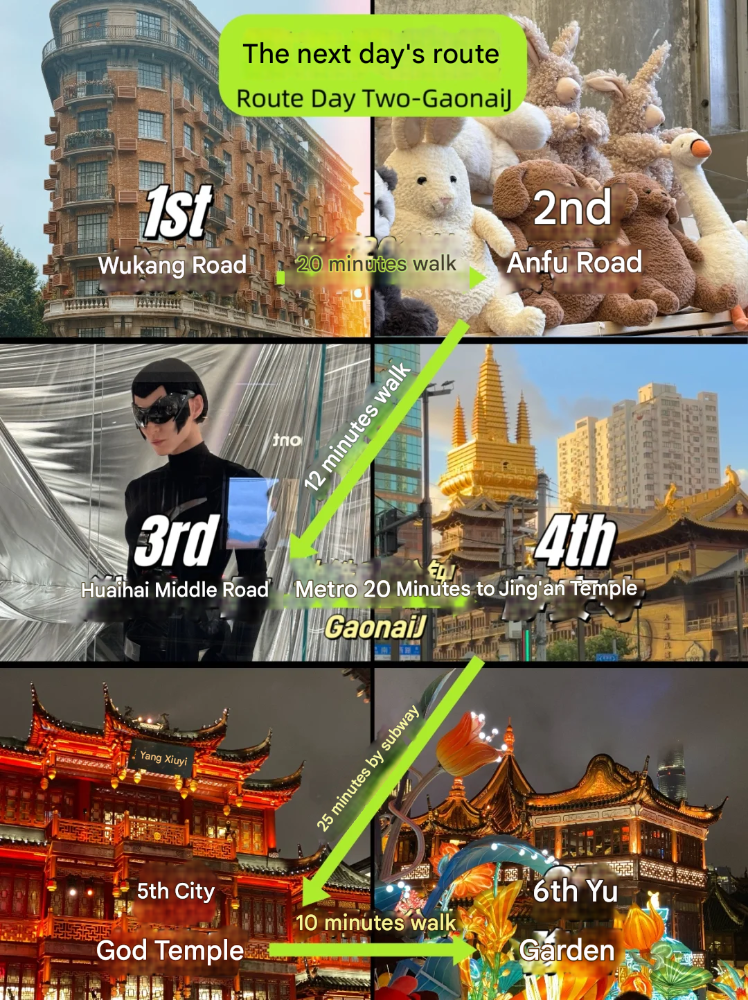 🗺️Wukang Road⏩️Anfu Road⏩️Huaihai Middle Road⏩️Jing'an Temple⏩️Chenghuang Temple⏩️Yu Garden 📍Wukang Road: A celebrity road that condenses the modern history of Shanghai for a hundred years, with many foreign-style houses and super fun to visit 📍Anfu Road: Long history and rich literature, many trends Shops 📍Huaihai Middle Road: Shanghai’s trendy area 📍Jing’an Temple: A golden temple in a prime location, worship it 📍Chenghuang Temple: Experience Shanghai’s traditional culture and authentic snacks 📍Yu Garden: A private garden in Jiangnan, where you can enjoy lights at night 💓Day 3️⃣ 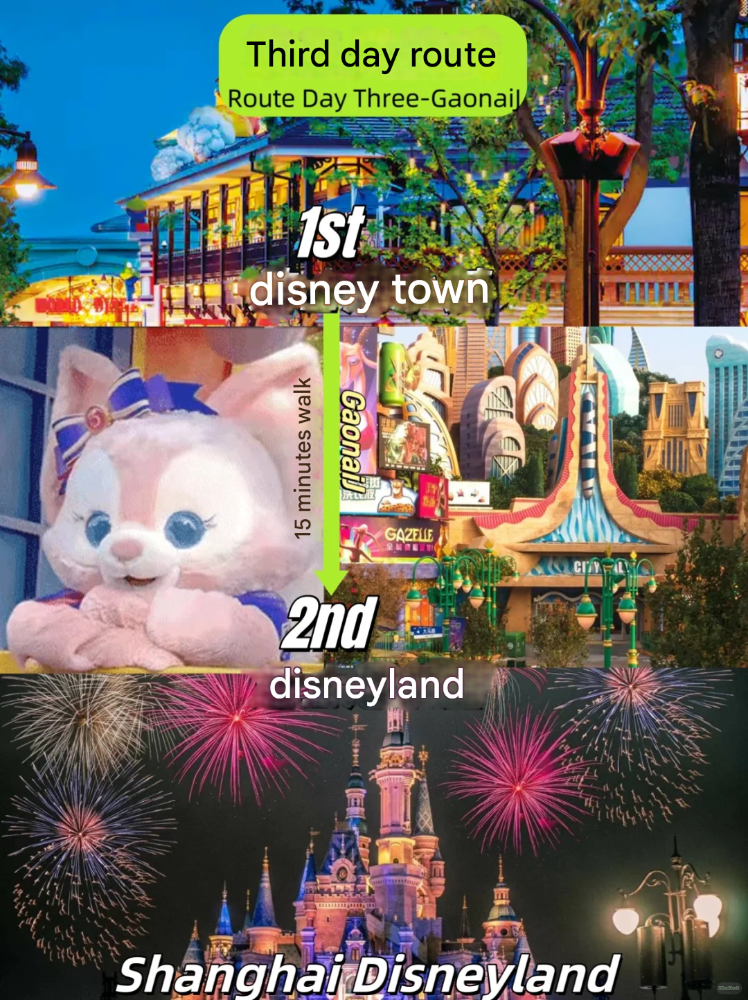 🗺️Disneytown⏩️Disneyland 📍Disneytown: You can eat around Disney, and there are discounts with your ticket 📍Disneyland: 1️⃣TRON Lightcycle Power Run-Exciting small roller coaster 2️⃣Roaring Mountain Rafting-The best choice in summer, check in “Pudong’s highest peak, Roaring Mountain” 3️⃣Crazy Animals 4️⃣ Pirates of the Caribbean - naked eye 3D effect, sensory enjoyment 5️⃣ Disney parade: a chance to interact with Linna Belle, Daji of Chuansha 6️⃣ Fireworks show: go early to reserve a spot 👨🏻🍳 Selected several authentic Shanghai-style delicacies 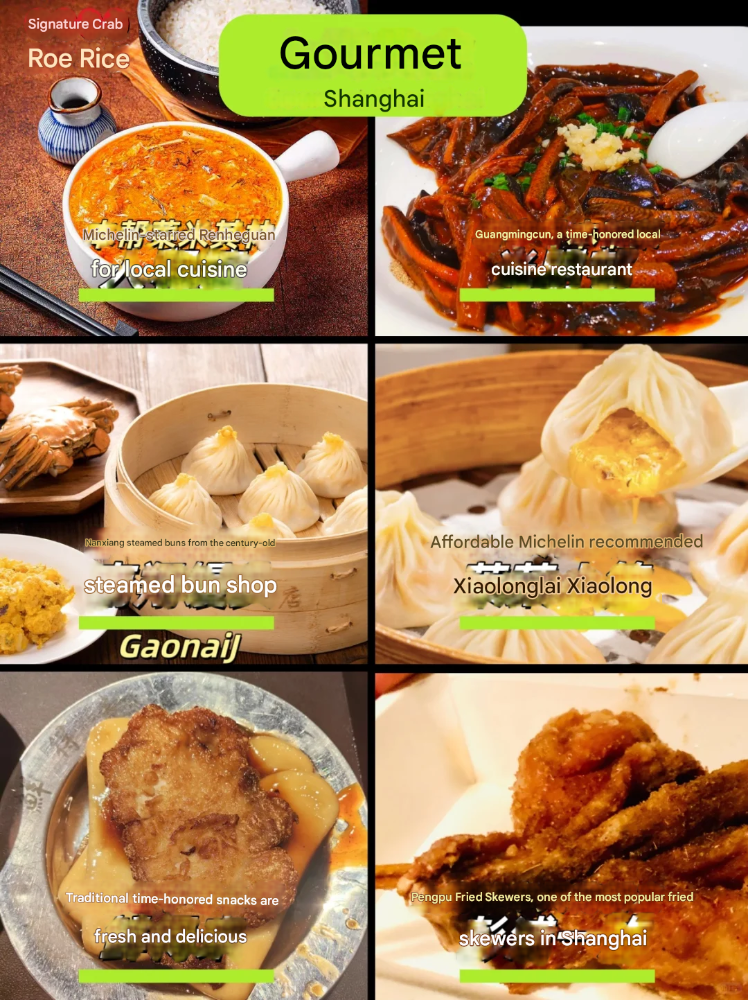 🍴 Renheguan's crab roe rice 🍴 Guangmingcun's fried eel shreds and fresh meat mooncakes 🍴 Nanxiang steamed bun shop and Lailai Xiaolong's crab roe steamed buns 🍴 Fresh pork ribs and rice cakes 🍴 Pengpu Yizhai's fried chicken legs and chicken fillets 💫 Just eat, one bite without a squeak
If you come to Shanghai on holiday, instead of going to the Bund to squeeze in the crowds and take the same old tourist photos, you might as well try this North Bund route located in Hongkou. 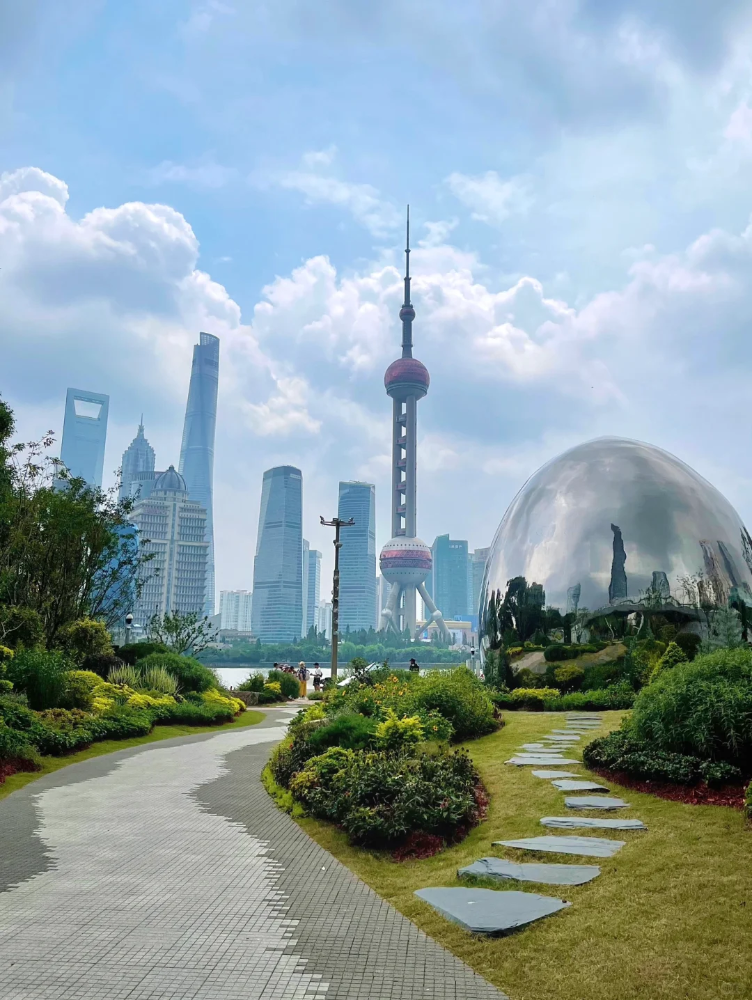 Compared with the Bund, there are much fewer people here, and there are many excellent shooting positions, and you can also take in the scenery of both sides of Lujiazui and the Bund. 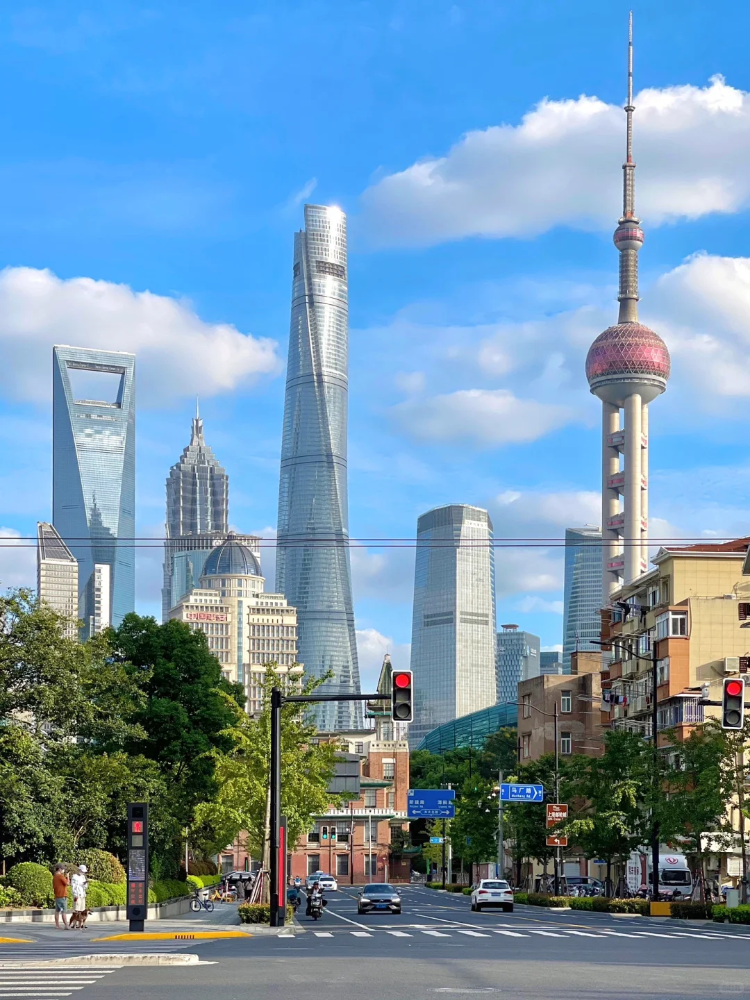 📍No. 200 Huangpu Road, North Bund International Living Room (Figure 1⃣️) Located at the junction of the Huangpu River and Suzhou River, the route can start from here. The view is superb, and there are really few people. With a telephoto lens, you can also take futuristic blockbusters in minutes  📍No. 500 Dongdaming Road, North Bund International Passenger Center (Figure 2⃣️-Figure 3⃣️) The most essential area of North Bund, the silver water drop here is matched with the Oriental Pearl and three-piece suits, full of technology. In the same scenic area, there are Magic City Matrix, TOL Guangting, etc. where you can take photos and check in together 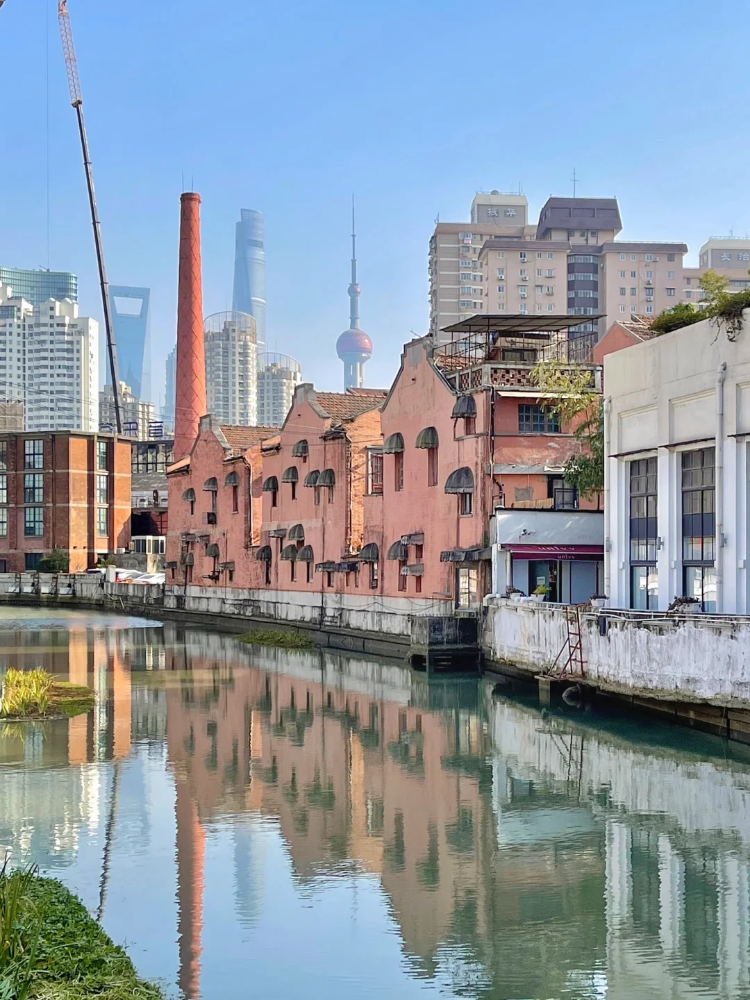 📍The intersection of Lushun Road and Machang Road (Figure 4⃣️) 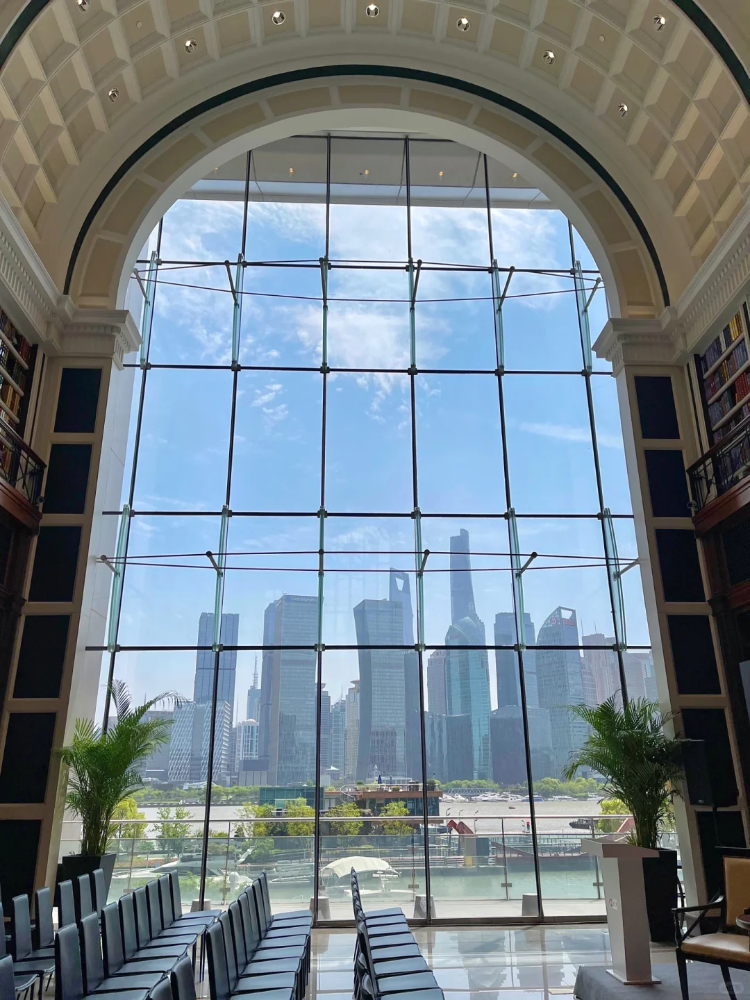 📍The intersection of Harbin Road and Liaoning Road (Figure 5⃣️, Figure 6⃣️) 📍Jiulong Road (Figure 9⃣️) 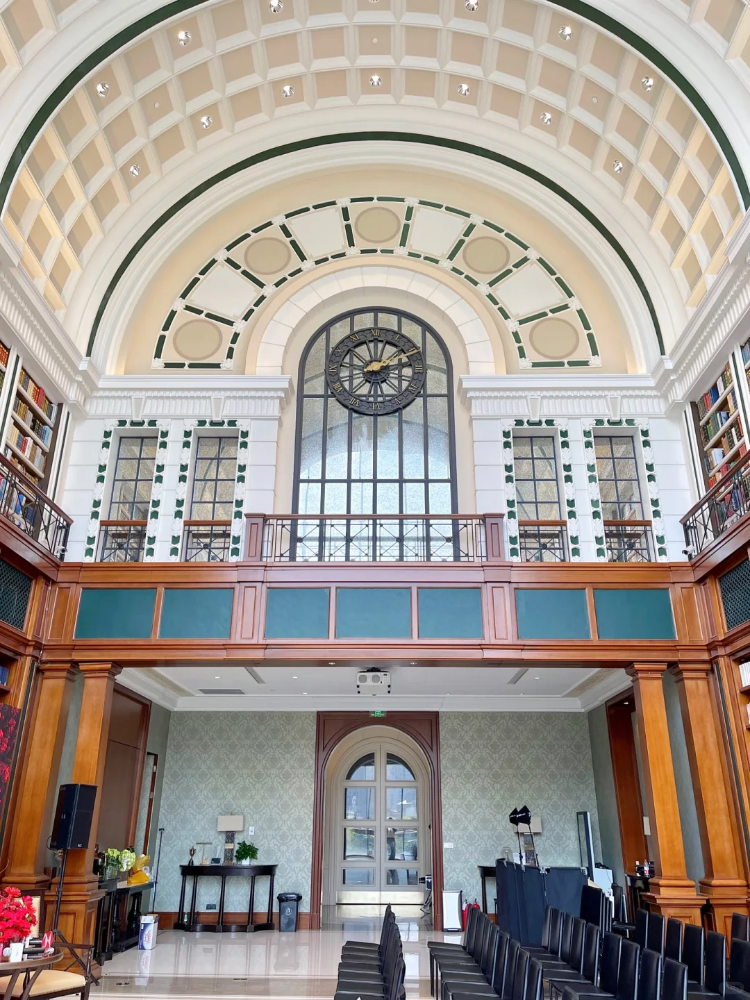 They are also classic shooting positions. The style of the old city and the new landmarks of the city in the distance are framed in contrast, forming a unique picture that is both modern and full of fireworks 📍No. 18 Gongping Road, Jiantou Bookstore (Figure 7-Figure 8) 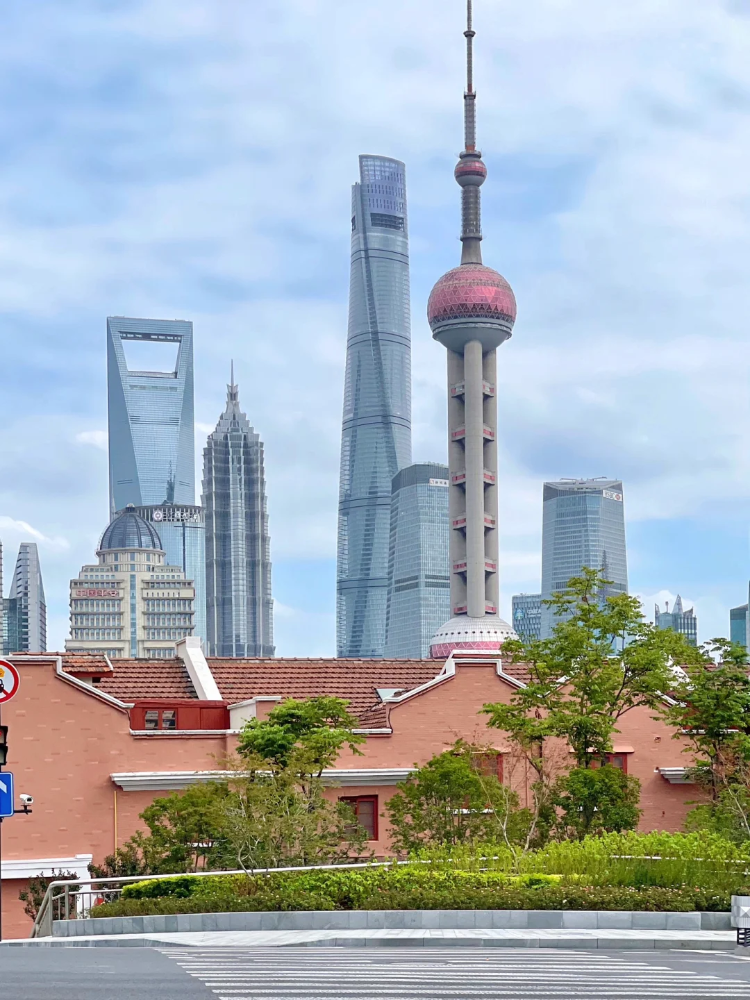 It is called the real version of "Hogwarts" and is decorated in a full British style. The huge floor-to-ceiling windows have an excellent view. In addition to being a bookstore, there are also coffee and self-study areas, and exhibitions are held from time to time
Thirty years ago, Pudong was a tidal flat, but now it has become the financial center of Asia. As a history and culture enthusiast, I am curious about the changes in Pudong. The skyscrapers in the Lujiazui Financial District are a symbol of China's reform and opening up. The Oriental Pearl Tower, **Shanghai Tower and Jinmao Tower are three super high-rise buildings that stand side by side and have become the new landmark of Shanghai.** Shanghai Disneyland adds a touch of fantasy to the city, where both adults and children can find their own happiness. Pudong's development speed is amazing. It has witnessed the take-off of China's economy and also foreshadows a more brilliant future.
Jinhua City, a prefecture-level city under the jurisdiction of Zhejiang Province, is located in the central part of Zhejiang Province. It is adjacent to Taizhou City in the east, Lishui City in the south, Quzhou City in the west, and Shaoxing City and Hangzhou City in the north. It belongs to the hilly basin area of central Zhejiang Province, with high terrain in the north and south and low terrain in the middle. It has a mid-subtropical monsoon climate with distinct four seasons, moderate annual temperature, abundant heat, and heavy rainfall. The total area is 10,942 square kilometers. [2] [33] As of the end of 2023, Jinhua City has jurisdiction over 2 districts, 3 counties, and administers 4 county-level cities. [5] As of the end of 2024, Jinhua City has a permanent population of 7.209 million. [101] Jinhua City is a central city in central and western Zhejiang Province, a national historical and cultural city, an inland open national comprehensive transportation hub city, an important innovative smart manufacturing city in the Yangtze River Delta region, an important growth pole in the southern wing of the Yangtze River Delta, and an inland open hub center city. [1] Jinhua (Wushang County) has been established for more than 2,200 years. It was originally part of the Yue Kingdom and was incorporated into Kuaiji County during the Qin Dynasty. It was named because it was "located where the two stars Venus and Wu Nu compete for brilliance". Since the establishment of Dongyang County in the first year of the Wu Baoding Period (266 AD) during the Three Kingdoms Period, it has a history of more than 1,800 years and a splendid culture. It is a national historical and cultural city. [2] [11] Jinhua City is known as "a historical and cultural state, a place where celebrities gather, a city with flourishing literary style, and a beautiful hometown with clear waters and beautiful mountains". [2] Scenic spots in the city include the national scenic area Shuanglong Cave and Huang Daxian Ancestral Temple. On October 1, 1949, seven outstanding Jinhua people, including Chen Wangdao, Shi Fuliang, Feng Xuefeng, Yan Jici, Wu Han, Qian Jiaju and Ai Qing, went up to the Tiananmen Gate Tower together with Mao Zedong, Liu Shaoqi, Zhou Enlai, Zhu De and other founding leaders to participate in and witness the birth of New China. [104]
Xiamen City, abbreviated as "Xia" or "Lu", is a prefecture-level city, a sub-provincial city, a separately planned city, and a Type I large city under the jurisdiction of Fujian Province, China. [164] [198] It is located on the southeastern coast of Fujian Province [186]. It faces the Big and Small Kinmen Islands to the east and Longhai District of Zhangzhou City to the south. It borders Nan'an City of Quanzhou City, Anxi County of Quanzhou City, Changtai District of Zhangzhou City, and Longhai District of Zhangzhou City by land. [207] It has a total area of 1,700.61 square kilometers and the language used is the Minnan dialect. [123] As of the end of 2023, Xiamen City has 6 districts under its jurisdiction; by the end of 2024, the permanent population of Xiamen City is 5.35 million [225]; the Municipal People's Government is located at No. 61 Hubin North Road, Siming District. [204] The territory of Xiamen City consists of the mainland area along Xiamen Bay in the southeast of Fujian Province, as well as the islands of Xiamen Island, Gulangyu Island, and Xiamen Bay. The terrain slopes from northwest to southeast, and is mainly composed of coastal plains, terraces, and hills. It has a subtropical marine monsoon climate, with mild and rainy weather, no severe cold in winter, and no scorching heat in summer. [205] In ancient times, Xiamen Island was a habitat for egrets, so it was also called "Egret Island". During the Western Jin Dynasty, Tong'an County was established. In the 27th year of Hongwu in the Ming Dynasty (1394), Xiamen City was built. In 1935, Xiamen City was established. In 1980, Xiamen Special Economic Zone was established. In 1988, it became a separately planned city. In 1994, it was promoted to a sub-provincial city.
Qinhuangdao City, referred to as "Qin", also known as the Port City, is a prefecture-level city under the jurisdiction of Hebei Province. It is a Type II large city [54]. It is located in the northeastern part of Hebei Province in North China, bordering the Bohai Sea to the south, Yanshan Mountain to the north, Liaoning to the east, and Beijing and Tianjin to the west. It is located at the junction of the two major economic zones of North China and Northeast China, and is located in the central area of the Bohai Rim Economic Circle. It is an important functional area of the capital economic circle [2-4] and one of the first coastal open cities. Qinhuangdao City is an important node city, a modern marine city, and a national comprehensive transportation hub city in the Beijing-Tianjin-Hebei region approved by the State Council. It is a national coastal tourism destination [1] [95]. As of 2024, Qinhuangdao City has 4 districts and 3 counties under its jurisdiction, with a land area of 7,802 square kilometers, a sea area of 1,805 square kilometers, and a permanent population of 3.1114 million. [114] Qinhuangdao City was named after the emperor Qin Shi Huang, who sent people to the sea to seek immortality during his eastern tour. It is the only city in China named after an emperor. [97] It is 280 kilometers from Beijing, 240 kilometers from Tianjin, and 380 kilometers from Shenyang. [93] Five national railway trunk lines, namely the Beijing-Shanhai Railway, Beijing-Qinhuangdao Railway, Daqin Railway, Qinshen Railway, and Shenshan Railway, intersect here. The Tianjin-Qinhuangdao High-speed Railway, Beijing-Shenyang Expressway, Qinbin Expressway, Chengqin Expressway, Qinhuangdao-Shenyang Expressway, Beijing-Qinhuangdao Expressway, and Qintang Expressway run through the entire area. [102] Shanhaiguan District is a national historical and cultural city [5] [40] [58-59]. Qinhuangdao Port is the world's largest energy export port [86] and China's earliest independent trading port.
Nanchang City, abbreviated as "Hong" or "Chang", is a prefecture-level city and provincial capital under the jurisdiction of Jiangxi Province. It is an important central city in the middle reaches of the Yangtze River, a national historical and cultural city, and a national comprehensive transportation hub city approved by the State Council.
Beihai City, also known as "Pearl City", is a prefecture-level city under the jurisdiction of Guangxi Zhuang Autonomous Region. It is located at the southern end of Guangxi and on the northeastern shore of Beibu Gulf. Beihai is an important starting port of the ancient "Maritime Silk Road" and one of China's earliest foreign trade ports.
Lianyungang, formerly known as Haizhou, is a prefecture-level city in Jiangsu Province, China. Located on the central coast of China, it borders the Yellow Sea to the east and connects to Xuzhou and Suqian to the west. The city covers a land area of 7,615 square kilometers and a sea area of 7,516 square kilometers. As of 2024, Lianyungang has a permanent population of 4.5817 million. The city is known for its coastal scenery and has two national 5A-level scenic spots: Liandao and Huaguo Mountain, along with 14 4A-level scenic areas.
Chengdu (Sichuan dialect international phonetic alphabet: /tsʰən˨˩tu˧sɿ˨˩˧/), also known as "Rongcheng", "Jinguancheng", "Jincheng", abbreviated as "Rong" and "Jin", is located in the central part of Sichuan Province, China, in the hinterland of the Chengdu Plain in the west of the Sichuan Basin. It is the capital of Sichuan Province, a sub-provincial city, and a national central city. It is the logistics, trade, finance, science and technology, culture, education center and transportation and communication hub in western China. It is also the location of the Joint Operations Command of the Western Theater Command of the People's Liberation Army of China [5] and a national pilot zone for coordinated urban and rural comprehensive supporting reforms. [6] The total permanent population of Chengdu is 21.403 million (2023 data) [7], and the Municipal People's Government is located at No. 2 Jinyue West Road, High-tech Zone. Chengdu is one of the cities in China that was developed earlier and has continued to prosper for a long time. According to the excavation records of the Jinsha Ruins, the history of Chengdu can be traced back to 3,200 years ago. [8] Chengdu was once the capital of nine regimes: Ancient Shu, Chengjia, Shu Han, Cheng Han, Qiao Shu, Former Shu, Later Shu, Li Shu, and Daxi. It is rich in the culture of the Three Kingdoms. Since the Qin and Han Dynasties, Chengdu has been famous for its prosperous agriculture, handicrafts and culture. It has been an important city in the political, economic, cultural and military center of southwest China. In the Han Dynasty, Chengdu was listed as one of the five major metropolises along with Luoyang. In the Tang Dynasty, commerce flourished and it was as famous as Yangzhou, known as "Yangzhou One and Yizhou Two" [9][10]. Chengdu has many famous places of interest such as Dujiangyan, Wuhou Temple, Du Fu Thatched Cottage, and Jinsha Ruins. It is one of the first national historical and cultural cities and one of the ten ancient capitals [11]. In 2007, it was named "China's Best Tourist City" by the National Tourism Administration of the People's Republic of China and the World Tourism Organization. [12][a] In 2009, the World Center for Excellent Tourism Destination Cities awarded Chengdu the title of "World Excellent Tourism Destination City". Chengdu is the first city in Asia to receive this honor. [13] In 2010, UNESCO approved Chengdu to join the UNESCO Global Creative Cities Network and awarded Chengdu the title of "Food Capital", making it the first "Food Capital" in Asia. [14] In 2021, the total GDP ranked second among the provincial capital cities in China, second only to Guangzhou, reaching 1,991.698 billion yuan. [15] According to the global city ranking analysis released by GaWC, Chengdu has been promoted to the "Beta+" echelon of global cities. [16] After the 2021 Summer World University Games [17] was held in Chengdu, the 2025 World Games will also be held in Chengdu.
The central urban area of Shanghai, with famous attractions such as the Bund and Nanjing Road. Huangpu District is under the jurisdiction of Shanghai and is the economic, administrative and cultural center of Shanghai. [89] It is located in the central part of Shanghai's downtown area, at the southwest end of the confluence of the Huangpu River and Suzhou River. It starts from Suzhou River in the north, borders the Huangpu River in the east and south, and extends to Chengdu North Road, Yan'an Middle Road, Shaanxi South Road, Zhaojiabang Road, and Ruijin South Road in the west. The district covers an area of 20.52 square kilometers [11], of which 18.71 square kilometers are land and 1.81 square kilometers are water. [11] As of the end of 2023, it has 10 sub-districts under its jurisdiction [67] [69] and a permanent population of 504,700 [85]. Huangpu District carries the history of Shanghai's more than 700 years of city construction and more than 180 years of port opening, and has witnessed the development and changes of Shanghai as an international metropolis. [47] From the tenth year of the Tianbao reign of the Tang Dynasty (751 AD) to the Song Dynasty, it belonged to Huating County. After the district adjustment in December 1959, it was divided into Huangpu District, Luwan District, and Nanshi District. After two “reconstruction” in 2000 and 2011, Huangpu District was established [47]. Huangpu District has four distinct seasons, abundant rainfall, and a long frost-free period. It has a subtropical monsoon climate [36]. It is located in the northeast of the saucer-shaped depression of Taihu Lake and belongs to the saucer edge highland [36]. During his work in Shanghai [47], General Secretary Xi Jinping positioned Huangpu as the “heart, window, and business card” of Shanghai [47]. In June 2020, Huangpu District was selected as the first batch of national demonstration areas for the construction of a law-based government [48]. In January 2021, Huangpu District became the first batch of national cultural and tourism consumption pilot cities [49]. In 2023, Huangpu District will achieve a year-on-year growth of 5.9% in gross regional product (GDP) [85]. In 2024, Huangpu District will achieve a GDP of 334.441 billion yuan, a year-on-year increase of 5.0%.